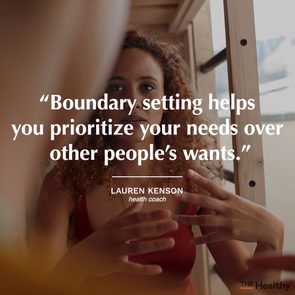13 Easy Phrases That Will Help You Set Healthy Boundaries
Updated: May 27, 2021
Maintaining a healthy emotional space is crucial for your mental well-being. These phrases will help you set boundaries with your partner, friends, coworkers, and even strangers.
Why you need to set boundaries
Healthy boundaries are crucial to our mental health, and most of us know we should set them. The tricky part: learning how to say no without worrying we’ll lose friends or anger family.
That fear is understandable, but it’s essential for your health and well-being to set boundaries with others, says Carrie Landin, a psychologist with UCHealth Integrative Medicine Center and a clinical instructor for the Department of Psychiatry Residency Program at the University of Colorado.
Learning how to set boundaries is a form of self-care.
“Without boundaries, you can feel taken advantage of, taken for granted, or imposed upon,” says Holly Schiff, a licensed clinical psychologist based in New York and Connecticut. “You are prioritizing your own comfort over the comfort of others, and that’s OK to do!”
Types of boundaries
Boundaries are the framework for acceptable behavior and the way you communicate that to others.
Effective boundaries reflect your personal values and priorities, evolve over time, and establish context for how a person will respond if someone else crosses the line, says Arianna Galligher, a social worker, field instructor, and associate director of the STAR Trauma Recovery Center at The Ohio State University Wexner Medical Center.
There are six basic types of boundaries:
- Material: These determine what (if anything) you are willing to give or share with someone else.
- Physical: These protect your personal space and privacy.
- Mental: These establish your right to have your own thoughts, values, beliefs, and opinions, even if they don’t align with someone else’s belief system.
- Emotional: Your emotions belong to you, and other people’s emotions belong to them. You are only responsible for your own emotions.
- Sexual: These protect your right to choose your comfort level with sexual activity.
- Spiritual: These allow you to determine your own relationship with God or a higher power.
Boundaries benefit both parties
Assumptions and inferences are the opposite of boundaries.
While they may feel easier in the moment—”Eh, they’ll figure it out eventually”—this type of unclear communication often leads to more pain, confusion, and contention in the long run.
“Boundaries should be a normal part of what you do in every relationship,” Landin says. “When you fuse your needs, emotions, and responsibilities with those of others, you create stress for yourself and you take away the other person’s right to have their space and experience separate from yours.”

Scripts to set boundaries for every occasion
Not sure exactly what to say? Our experts share some simple scripts for establishing your boundaries in a clear and caring way. People pleasers, take note.
Validate their feelings + boundary
Boundaries don’t require an explanation, but if you’re establishing them for someone with whom you have a close relationship, like an intimate partner, it can help that person better understand where you’re coming from.
One way to do this is to validate the feelings behind the request they are making.
Example
“I hear that you are feeling disconnected and you want to spend more time together. I love you, and I want that too! I can’t do it tonight because I have a meeting, but what about Saturday?”
Gratitude + boundary
Thanking people, even if you aren’t feeling particularly grateful, is a quick way to defuse a situation. It helps others feel heard and validated without committing you to doing what they ask.
This type of boundary-setting is great for strangers in public, or for people with whom you only have a passing relationship, like a neighbor.
Example
“Thank you for your concern about my child’s behavior. I’ll take it from here.”
Safety rule + boundary
Some boundaries are nonnegotiable because they involve protecting yourself or someone else.
A firm “no” is just fine in this case, but if you want to be clearer, you can expand on the safety issue without giving personal or sensitive information.
Example
“That question is too personal. I don’t share those kinds of details with people I don’t know very well.”
Sympathy + boundary
Emotional boundaries can be some of the most difficult to enforce, particularly within close relationships.
You can be sympathetic or empathetic to someone’s plight, however, without taking on their problems as your own or trying to fix them.
Example
“Wow, I can really see what a difficult experience this has been for you and how painful it’s been. I don’t have any advice for you, but I am here to listen and support you.”
Restatement + boundary
Setting boundaries can sometimes feel like you’re being dismissive of other people’s needs. To avoid that, and to help them feel heard, you can restate what they are asking and then state your boundary. “You can care about a person and also say, ‘No, I can’t do that right now,'” Landin says.
Example
“So you’d like me to help you clean and organize the garage? I’m exhausted from work today and don’t have the energy for such a big project now. Can we plan a time tomorrow to work on it together?”
Say nothing
“Sometimes we don’t have to say anything out loud to set a boundary,” Landin says. “You can set parameters for certain types of interactions or communications without explaining them.” This is particularly helpful if you’re worried the other person may argue with you.
Example
Decide you will return texts within 12 hours, not necessarily immediately, or that you will not accept phone calls during work hours. You can also decide to avoid discussing a certain topic, like politics, with a particular person.
Boundary + schedule
You don’t have to drop everything the second someone needs you to do something.
If you can’t commit to someone’s request at the moment but you could in the future, however, it’s important to be clear about exactly when and how you’ll do that.
Example
“I’m working on something else right now, but I can meet with you at 2 p.m. today to discuss your question.”
Boundary + resources
Part of boundary setting is learning what you can and can’t give to others. There will be situations where you simply don’t have the knowledge or resources to help in the way they need—and it’s OK to say that.
Example
“I’ve given all the advice about your relationship that I know. I still want to be supportive, but maybe you’d benefit from talking to a couples therapist about how to handle those problems. I can give you the number of one I like.”
Boundary + alternate solutions
Just because someone tells you something must be done a specific way, that doesn’t mean you have to comply (unless that’s your job). People often get frustrated, however, if you shoot down their idea without offering another solution to the problem at hand.
Example
“I won’t be able to take on that project right now and complete it in the time frame the customer wants. We could extend the deadline or see if someone else can help work on this.”
Their boundary + your boundary
Setting your boundary sometimes depends on the other person’s comfort level. It’s appropriate to check in with them first by asking a question that allows them to state their own boundary.
Example
“Would it be OK if I gave you a hug? I don’t have time to talk right now, but it looks like you could use some support.”
Your emotions + boundary
Your emotional well-being should be important to your loved ones, so sharing how you feel can help clarify the boundary.
Example
“I feel neglected and hurt when you look at your phone while I’m talking to you. Can we have a ‘no phones at the dinner table’ rule?”
Boundary + request
Boundary-setting isn’t just for when people make requests of you. It’s OK, even preferable, to tell others about your needs and how they can help you while still respecting both parties’ boundaries.
Example
“I’m feeling really lonely, and I need some time with my best friend. Would you be available to go grab coffee today or tomorrow?”
Exit + boundary
Firm boundaries are part of maintaining relationships, but they are also part of ending them if that becomes necessary.
If you need or want to break ties with someone, it’s important to be very clear about your boundaries for physical space and communication. It may hurt more in the moment, but it won’t leave either of you guessing or wondering what’s next.
Example
“This isn’t a productive conversation. I’m logging off now; don’t message me again.”
Next, learn how to build a self-care plan.



